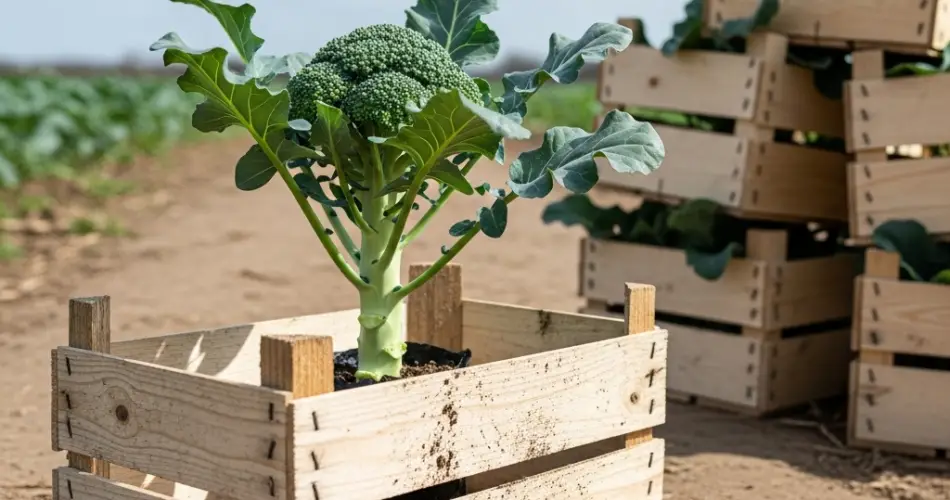Broccoli is a nutrient-rich vegetable packed with vitamins, minerals, and antioxidants that support a healthy diet. Known for its slightly earthy flavor and versatility in the kitchen, broccoli can be enjoyed steamed, roasted, stir-fried, or even raw in salads. While many gardeners assume this cool-season crop requires a traditional garden bed, broccoli adapts surprisingly well to crate gardening. By growing broccoli in crates, even urban gardeners with limited space can enjoy compact yet abundant harvests.
This method provides control over soil quality, better pest management, and flexibility in garden design. With the right approach, crates can deliver fresh broccoli right from your balcony, patio, or small backyard.
Why Grow Broccoli in Crates?
Crate gardening offers a number of benefits for broccoli cultivation:
-
Space-Saving: Perfect for small homes, apartments, or patios.
-
Mobility: Crates can be moved to chase sunlight or avoid extreme weather.
-
Soil Customization: Growers can create the perfect soil blend for broccoli.
-
Aesthetic Value: Wooden crates add rustic charm to compact gardens.
This approach not only makes growing broccoli accessible but also creates a tidy, organized look for small-space gardening.
Choosing the Right Crate
The success of your broccoli harvest starts with selecting the right container. Broccoli develops moderately deep roots, so crates must provide enough room for growth.
-
Depth: At least 12–16 inches deep.
-
Width: 18–24 inches, allowing one plant per crate for proper spacing.
-
Drainage: Drill several holes in the base to prevent waterlogging.
Line the crate with breathable landscape fabric or burlap. This keeps soil from escaping while maintaining healthy drainage.
Best Broccoli Varieties for Crates
Compact varieties are ideal for crate gardening, as they don’t require as much space as traditional types. Some excellent choices include:
-
De Cicco: A smaller, fast-growing variety with plenty of side shoots.
-
Packman: Early-maturing and well-suited to containers.
-
Waltham 29: A cold-tolerant variety that thrives in extended seasons.
-
Calabrese: Classic broccoli with reliable yields.
Opting for compact or early-maturing types ensures better productivity in limited crate space.
Preparing the Soil
Broccoli thrives in rich, fertile, and well-draining soil with a slightly acidic to neutral pH (6.0–7.0). A balanced crate mix should include:
-
40% quality garden soil.
-
40% compost or aged manure for nutrients.
-
20% sand, perlite, or coco coir for aeration and drainage.
Before planting, mix in a slow-release organic fertilizer to provide essential nutrients for steady growth.
Planting Broccoli in Crates
You can grow broccoli from seeds or seedlings. Seedlings often give a quicker start and more reliable harvests.
-
Fill the crate with prepared soil, leaving a few inches of space at the top.
-
Plant one seedling per crate, ensuring spacing of 12–18 inches.
-
Firm the soil around the roots and water thoroughly.
Place the crate in a location with at least 6 hours of direct sunlight daily for optimal growth.
Watering and Light Requirements
Broccoli is sensitive to inconsistent watering, which can lead to small or bitter heads.
-
Watering: Keep soil evenly moist, but never soggy. Water when the top inch feels dry.
-
Sunlight: Provide 6–8 hours of sunlight per day. In hotter regions, partial afternoon shade helps reduce stress.
-
Mulching: Add mulch around the plant base to conserve moisture and stabilize soil temperature.
Consistency in water and light is the key to compact yet productive harvests.
Feeding Your Plants
Because broccoli is a heavy feeder, regular fertilization supports strong growth and full heads.
-
Apply a nitrogen-rich fertilizer during early leaf development.
-
Switch to phosphorus- and potassium-rich formulas once heads begin forming.
-
Use liquid seaweed or compost tea every 2–3 weeks to boost soil vitality.
This ensures your crate-grown broccoli produces firm, flavorful harvests.
Pest and Disease Management
Broccoli can attract pests and diseases, but crate gardening makes prevention easier.
-
Common Pests: Aphids, cabbage worms, and flea beetles. Control them with neem oil or insecticidal soap.
-
Fungal Issues: Prevent downy mildew and root rot by ensuring good drainage and airflow.
-
Protection: Lightweight row covers help deter insects during early growth stages.
Regular monitoring keeps problems under control before they affect the crop.
Harvesting Compact Broccoli
The main broccoli head is ready for harvest when it feels firm and the buds are tightly closed. Cut the head with a sharp knife, leaving several inches of stem attached.
After harvesting the central head, many varieties, such as De Cicco, produce smaller side shoots. These can extend your harvest for several weeks, making crate-grown broccoli especially rewarding.
Final Thoughts
Growing broccoli in crates allows anyone—regardless of space limitations—to enjoy compact and nutritious harvests. By selecting the right crate size, preparing fertile soil, and maintaining consistent care, you can produce healthy broccoli plants that thrive in small spaces.
This method offers flexibility, mobility, and control, ensuring successful yields even on balconies or patios. Fresh, homegrown broccoli from crate gardening proves that you don’t need a traditional plot to cultivate nutrient-rich vegetables. With just a little effort and attention, your crate-grown broccoli can become a reliable source of delicious, garden-to-table meals.



